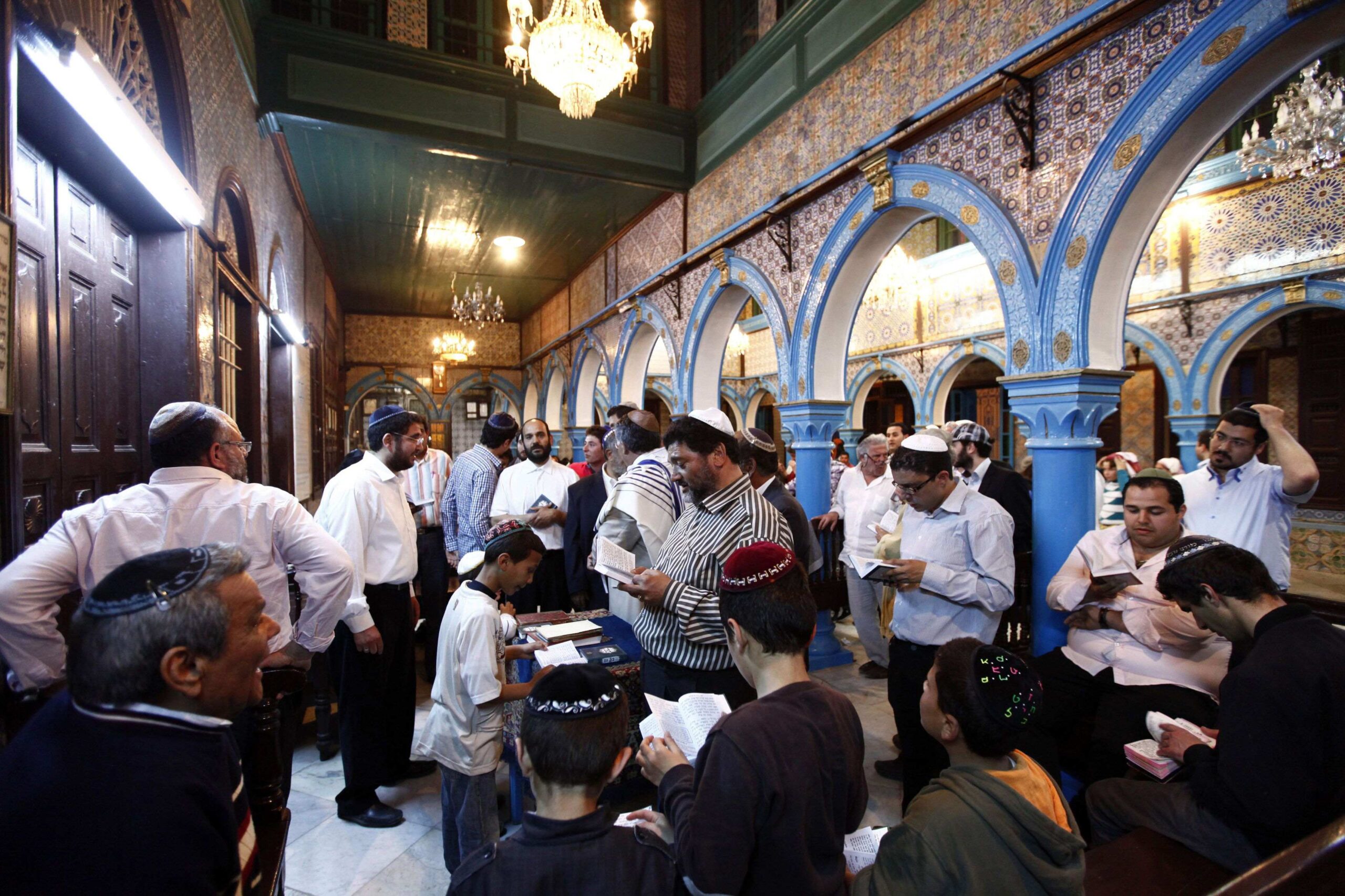According to a local tradition, the Jewish settlement in Djerba also spelled Jerba dates from the reign of King Solomon and so was founded the present al-Ḥāra al-Kabīra (the “Big Quarter”). A family of Kohanim, priests fleeing Jerusalem in the year 70 C.E. is said to have transported one of the Temple gates from Jerusalem to Djerba. It is believed to be enclosed in the Bezalel synagogue, known as al-Gharība (the “extraordinary”) of the Ḥāra al-Ṣaghīra (the “Small Quarter”), which is situated in the center of the island.
The Gharība was a much frequented place of pilgrimage. The Jewish population consisted mainly of Kohanim with a small sprinkling of others, although there were no members of the tribe of Levi, the tribe assisting the Kohanim, among the residents. According to tradition, the absence of Levites on the island is the result of a curse of death against them by Ezra because they refused to answer his request to send Levites to Israel at the time of Jewish return to Israel after the first exile. The history of the Jews of Djerba includes three serious persecutions: in the 12th century under the Almohads; in 1519 under the Spanish; and in 1943 under the Nazis. In 1239 a colony of Jews from Djerba settled in Sicily , where they obtained concessions to cultivate henna, indigo, and the royal palm groves. It was common for the male Jewish population of Djerba to look for livelihood abroad, but they kept returning to the island, where their families had remained. Exchange of goods with Malta and Italy was in the hands of the Jews, who grew the products and processed the commodities for export themselves.
In the 19th and 20th centuries the Yeshivot, Rabbinical academies, of Djerba produced many rabbis and writers and they provided rabbis for the communities of North Africa. In 1946 there were some 4,900 Jews in Djerba, settled in al-Ḥara al-Ṣaghīra, al-Ḥāra al-Kabīra, and Houmt-Souk, the principal town of the island. Their number dwindled to about 1,500 by the late 1960s, about 1,000 in 1976, 800 in 1984, and 670 in 1993, the majority immigrating to Israel. Those remaining dealt in jewelry and commerce, but the Jewish neighborhoods lost their purely Jewish character as Muslims moved in and the community was the victim of several anti-Jewish incidents. Across the rest of the Middle East, Jewish communities have been vanishing over the past half century, since the creation of Israel. Before then, there were more than 850,000 Jews living in the Arab world. Today, there are between 4,000 to 4,500, according to Justice for Jews from Arab Countries, a nonprofit advocacy group.
Some countries, such as Algeria and Libya, which once had sizable Jewish populations, have virtually no Jews within their borders. Egypt, which through the late 1940s had 75,000 Jews active in the country’s economic and social life, is down to a few dozen. Only Morocco, once home to 265,000 Jews, has a community of 2,500 left. Many are elderly or middle-aged.
As other Tunisian Jews moved away to Israel and France for fear of persecution, the Jews of Djerba stubbornly clung to the promise of their own future. A community that had dwindled to fewer than 700 Jews by the mid-1990s—from a high of about 5,000 in 1948—began to grow slowly but surely. While there were and still are departures, they are outweighed by the young families choosing to stay. Today, the island’s Jews number roughly 1,000, local leaders estimate. Mounting concerns about anti-Semitism in France, underscore what the Chief Rabbi of Tunisia has been saying for years: That no place is safer or more hospitable for Jews.
“The Jews of Djerba are concentrated in one area, so the government is able to protect us,” says Haim Bittan, the Chief Rabbi. A resident of Djerba, Rabbi Bittan also believes that the community’s deep spirituality offers it protection. “We have faith in God, that if we keep his laws and commandments, he will guard us from evil,” he says.
The central government in Tunis has long seen value in having a stable Jewish population. Even after the 2011 revolution ousted longtime President Zine El Abidine Ben Ali —the first casualty of the Arab Spring—the new leaders sought to assure Tunisian Jews that they were safe.
Djerba has enjoyed a lucrative tourist industry and Tunisia has been keen to preserve it by stressing its tolerance and moderation. Having a sizable Jewish community is key in that goal.
Djerban Jewish leaders are concerned about assimilation, so contacts with the 150,000 Muslims on the island are limited. Clustered in the Hara Kebira, the main Jewish quarter, they speak Arabic as well as Hebrew; a few speak French.
Relations between Jews and Muslims are complex—proper and respectful, though not especially close. Jewish men work alongside Arab merchants in the souk, for example, and enjoy amiable ties with Muslim customers.
With its low-lying houses and narrow, unpaved streets, the Hara Kebira is modest. While not walled in, it is insular and self-contained. Little boys run around in skullcaps; women wear long skirts, and scarves. And there are over a dozen working synagogues. The community is still Orthodox and insular but laptops, iPhones and TV sets are ubiquitous and more opportunities for women are being pushed for. Djerban Jews are proud of their heritage and want to preserve it even as the community has embraced aspects of modern culture. It is an ancient heritage of deep faith and it dwells on an island in space and in time.
For the most part this article is based on and quotes from http://www.jewishvirtuallibrary.org/jsource/judaica/ejud_0002_0005_0_05275.html and http://www.wsj.com/articles/insular-jewish-community-of-djerba-tunisia-has-weathered-revolution-and-terrorism-but-can-it-survive-girls-education-1423869146

